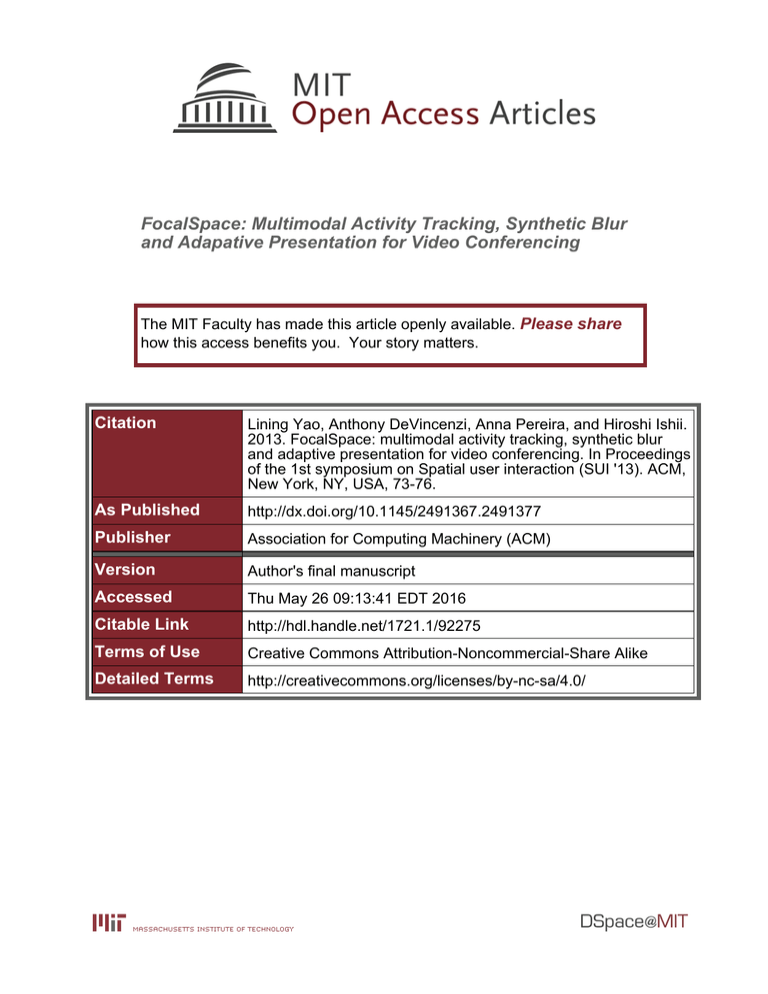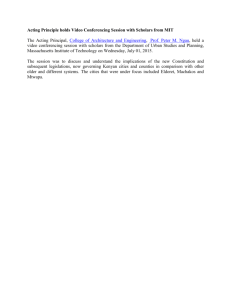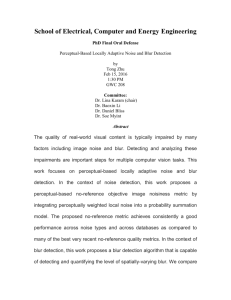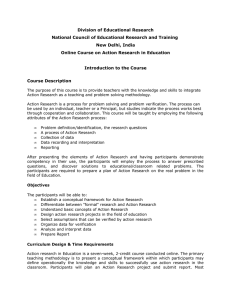FocalSpace: Multimodal Activity Tracking, Synthetic Blur
advertisement

FocalSpace: Multimodal Activity Tracking, Synthetic Blur
and Adapative Presentation for Video Conferencing
The MIT Faculty has made this article openly available. Please share
how this access benefits you. Your story matters.
Citation
Lining Yao, Anthony DeVincenzi, Anna Pereira, and Hiroshi Ishii.
2013. FocalSpace: multimodal activity tracking, synthetic blur
and adaptive presentation for video conferencing. In Proceedings
of the 1st symposium on Spatial user interaction (SUI '13). ACM,
New York, NY, USA, 73-76.
As Published
http://dx.doi.org/10.1145/2491367.2491377
Publisher
Association for Computing Machinery (ACM)
Version
Author's final manuscript
Accessed
Thu May 26 09:13:41 EDT 2016
Citable Link
http://hdl.handle.net/1721.1/92275
Terms of Use
Creative Commons Attribution-Noncommercial-Share Alike
Detailed Terms
http://creativecommons.org/licenses/by-nc-sa/4.0/
FocalSpace: Multimodal Activity Tracking, Synthetic Blur
and Adaptive Presentation for Video Conferencing
Lining Yao, Anthony DeVincenzi, Anna Pereira, Hiroshi Ishii
MIT Media Lab
75 Amherst St. E14-348P
Cambridge, MA 02142 USA
+1 87 253 9354
{liningy, anna_p, tonyd, ishii} @media.mit.edu
ABSTRACT
We introduce FocalSpace, a video conferencing system that
dynamically recognizes relevant activities and objects through
depth sensing and hybrid tracking of multimodal cues, such as
voice, gesture, and proximity to surfaces. FocalSpace uses this
information to enhance users’ focus by diminishing the
background through synthetic blur effects. We present scenarios
that support the suppression of visual distraction, provide
contextual augmentation, and enable privacy in dynamic mobile
environments. Our user evaluation indicates increased memory
accuracy and user preference for FocalSpace techniques compared
to traditional video conferencing.
Categories and Subject Descriptors
H.5.2 [User Interface]: Graphic user interface (GUI), Screen
design, user-centered design.
Keywords
Diminished reality; video conferencing; synthetic blur; focus;
attention; focus and context; depth camera.
1. INTRODUCTION
During face-to-face conversations, without conscious thought, our
eyes move in and out of different focal depths, fading out
irrelevant background imagery. However, in the case of
videoconferencing, this natural behavior is reduced by the
inherent constraints of a “flat screen” [9]. The background, which
can be distracting and contain unwanted noise, remains in focus.
While gaze and sound have been explored as potential cues
[16][17] to prevent visual distractions and enhance focus in video
conferencing, we were inspired by artists in cinematography who
direct people’s attention through Depth of Field (DOF). Previous
research has shown that differences between sharp and blurred
portions of an image can affect user attention [11]. In FocalSpace
(Figure 1), focus is placed on pertinent information and the
remainder is blurred, giving users visual indicators for selective
attention.
To emphasize pertinent information, we constructed a dynamic
layered space that allows participants to perceive different layers,
including foreground and background, in different focus.
Permission to make digital or hard copies of all or part of this work for
personal or classroom use is granted without fee provided that copies are
not made or distributed for profit or commercial advantage and that
copies bear this notice and the full citation on the first page. To copy
otherwise, or republish, to post on servers or to redistribute to lists,
requires prior specific permission and/or a fee.
SUI’13, July 20–21, 2013, Los Angeles, California, USA.
Copyright © ACM 978-1-4503-2141-9/13/07...$15.00.
Figure 1. FocalSpace: active speaker in focus, inactive speakers
dimmed 50%, and synthetic blur applied to background.
The focused foreground includes participatory and nonparticipatory individuals, activities such as sketching, and
artifacts, including props and projection walls. Through depth
sensing and hybrid tracking of multimodal cues, the system can
dynamically identify the foreground and apply the blur filter.
These types of visual effects are known as “Diminished Reality”
[12].
Our contributions include:
• Application of activity detection to videoconferencing through
multimodal tracking of audio, gesture and users’ proximity to
surfaces.
• Introduction of contextual synthetic blur to steer attention
towards relevant content, in the spirit of “Diminished Reality”.
• Proposed design scenarios including filtering visual detritus,
augmentation with contextual graphics, and privacy in mobile
environments.
• User evaluation that indicate increased memory accuracy and
preference for FocalSpace techniques over traditional video
conferencing.
2. RELATED WORK
2.1 Diminished Reality
Several different approaches of blur and focus have been used as
Diminished Reality in data visualization and on screen display to
direct people’s attention. One example is a geographical
information system with 26 layers that fades in and out through
blur and transparency [2]. A digital chess tutoring system shows
each chess piece in different blur level to indicate strategy step by
step [11], and a file browser was developed to show the age of
files through continuous blur [11].
2.2 Image Filters for Video Conferencing
“Multiscale communication”[14] was proposed with several
video-based communication systems using image filters aimed at
increasing engagement. In one example, blur was applied to the
entire video, not portions of interest. In addition, image filters
have been shown to effectively eliminate details while enhancing
others. Blur has, for example, been explored to enhance users’
sense of presence and portrayal [13].
2.3 “Focus + Context”
Some related work has demonstrated techniques for segmenting
foreground from background in video conferencing, such as
zooming [9] and gazing tracking and repositioning the focus [17].
Aforementioned systems treated speakers with gaze directed at
them, either one or multiple, as foreground. Kinected Conference
[4] introduced voice as a cue to trigger focus on speakers. Our
system builds on this previous work, while introducing multiple
cues such as gestures, proximity and voice, to track semantic
activities beyond “talking heads”. To enable the dynamic tracking,
“Layered Space Model” is proposed.
2.4 Foreground Sensing Technology
One approach of foreground sensing technology is to pre-capture
the background so that image elements that differ are calculated
and considered as foreground [5]. However, it requires a precalibration process. Face recognition cannot detect other
foreground elements beyond human faces. The availability of
depth sensing devices [1]for situated environments and their
expected imminent integration in mobile devices make the
approach scalable and applicable to a wide range of usage
scenarios.
3. SYSTEM DESCRIPTION
Our system was adapted to a traditional conference environment
with simple readily available components (Figure 2). Three depth
cameras are placed in front to optimally capture 3 sides of a
meeting table in a conference room. The optional peripheral setup
contains satellite-webcams pointing to predefined areas to access
high-resolution images of the specified regions.
through depth camera. Proximity between participants’ hands and
the marked object is tracked in real time.
3.2 Image Filter
The tracked foreground participants are taken in and out of focus
computationally. By applying the Fragment GLSL shader [15] to
the background pixels twice, horizontally then vertically,
Gaussian blur filter is generated for the video. The extent of blur
is a user-adjustable parameter, currently allowing blur to be set in
steps up to a ten-pixel radius. The system also allows multiple
areas of focus and blur at the same time.
4. INTERACTION TECHNIQUES
4.1 Dynamic Layered Space
In order to segment the scene based on activity, we divide the
remote space into two discrete layers (Figure 3), the foreground
and the background. Conference participants and objects of
interest exist within the foreground layer. Further, the foreground
layer contains active and inactive foreground: pertinent images,
such as the active speaker and active drawing surfaces, are
considered active foreground. Active foreground is presented in
focus. The remainder is inactive foreground that is focused, but
dimmed 50%. The background layer contains the less relevant
visual elements behind the foreground. Synthetic blur effects are
applied to diminish the salience of the background.
Figure 2. Three depth cameras and microphone arrays in front
of a video screen
Figure 3. Dynamic Layered Space: Divided into foreground and
background layers.
3.1 Hybrid Tracking of Multimodal Cues
4.2 Multimodal Activity Detection of
Semantic Events
Depth map and human skeleton data given by the Kinect camera
are used to track different cues [10]. A microphone array
embedded in the Kinect can track the audio cues from the
horizontal sound angles of users talking in front of the device.
Calibration matches each column of on-screen pixels with the
sound angle. If pixels from a person match with the sound angle
(10 cm buffer), the person is considered “active speaker” and
brought into focus. To prevent unexpected transitions, such as
from a natural pause in speech, there is a two-second delay before
focus-to-blur transitions.
The system also detects certain gestures, such as “hands up”. The
hand raising detection is based on skeletal tracking and
acceleration rate of the hand joint.
In order to detect how far away an active speaker is from a certain
location, proximity cue was tracked using depth maps of the target
location and the participants. If the average depth distance
between the two was smaller than 20cm, we considered the
participant to be approaching or working at a predefined location.
Additionally, in order to detect participants’ hands approaching an
arbitrary object, such as a sketchbook, the object is color marked,
thus the spatial location of the marked object can be tracked
Three cues, voice, gesture and proximity, are tracked to determine
the active foreground (Figure 4). In addition, remote listeners can
manually select the focus.
Audio Cue is used to detect the active speaker. The current
speaker is typically the most prominent foreground in group
meetings [17][2]. Once the current speakers are detected, they are
placed into active foreground and automatically focused on.
Gesture is detected to understand user intent. The ability to track
gestures enables the system to behave as a meeting leader, by
tracking people raising their hands, and putting the waiting person
into focus simultaneously with the active participant.
Since many kinds of communication make use of illustrations and
presentation, the system also supports a Proximity Cue. The
system tracks the active participants and activates focus on the
corresponding surfaces, when users interact with a drawing
surface or projection board.
Figure 6: Focus is sent to the mobile interface via network.
6. USER STUDY
Figure 4. Voice, Gesture and Proximity Cue
In addition, participants who wish to define an area, person, or
object of interest at their discretion, can use a user-defined
selection mode. Objects are presented as object hyperlinks with
common user interface behaviors such as hover and click states.
5. USER SENARIOS
5.1 Filtering Visual Detritus
Earlier work proposed the idea of utilizing blur effect on the video
rather than the “talking heads” area to direct audience’s attention
[4]. Based on our Layered Space Model, FocalSpace interprets
and updates the background in a more dynamic way. For certain
scenarios, such as a busy working environment or noisy cafeteria,
the background layer refers to the unwanted visual and auditory
clutter behind speakers. While during other meetings involving
frequent sketching and body movement, the background will
exclude both participants and working artifacts, such as
sketchbooks and whiteboards. By removing the unwanted
background visual distraction we are able to increase
communication bandwidth and direct participants’ focus on the
foreground activity.
5.2 Adaptive Presentation
FocalSpace diminishes unnecessary information and leave the
space for adding additional more relevant information to the
foreground layer.
Extending the former work of augmentation of “talking heads”
with depth sensing [4], FocalSpace provides spatially registered,
contextual augmentations of pre-defined objects. With an
additional camera, we are able to display a virtual representation
of a surface where a remote user is drawing. This technique
allows remote users to observe planar surfaces in real time that
would otherwise be invisible or illegible. We demonstrate
sketching on flip charts, paper and a digital surface (Figure 5).
As an initial evaluation of FocalSpace we performed a user study
of one fundamental aspect of FocalSpace: blur and focus. We
investigate how video conferencing with blur and focus compares
to video conferencing without, referred to as traditional
conferencing. In the study we test two alternative hypotheses:
H1: FocalSpace increases participant content retention.
H2: FocalSpace has increased user preference.
As previously highlighted, few user evaluations of video
conferencing with diminished and augmented reality exist. We
believe that an important first step is to quantify the advantages of
FocalSpace and diminished reality. We believe that FocalSpace
will increase user focus and therefore memory. Hence, we focus
on user memory in our user study. In future work, we plan to
follow up with investigations of our previously discussed
interaction techniques.
6.1 Methods
In this user study, 16 participants, 8 female, watched two sixminute prerecorded videos emulating video conferences with and
without FocalSpace effect. In order to keep the consistency of
distraction level and content intensity, prerecorded videos were
used instead of real time interactive video conferencing. Both of
the videos showed conversations between two users with similar
content and generality. Experimental conditions were
counterbalanced. The FocalSpace video was recorded with the
synthetic blur effect based on audio cues, with the blur level set to
three-pixel radius. The traditional video had no special effects.
Content questionnaires evaluated accuracy of user memory. Seven
multiple-choice questions were evenly distributed along the
timeline of the conversation. The final score was the average
percent correct per video. In addition, participants were
interviewed on usability and user experience.
Differences in total percent correct score for both FocalSpace and
traditional video were analyzed with a two tailed paired t-test.
Error bars were reported as standard error of the mean (SEM).
6.2 Results and Discussion
Figure 5: Contextual augmentation of local planar surfaces.
5.3 Privacy for Mobile Environments
We also developed a prototype to explore the FocalSpace concept
to more flexible environment using mobile devices (Figure 6).
Video stream is captured in front of a situated depth camera and
sent over to the phone interface via screen sharing tool [8]. Given
the ongoing development of wearable depth sensing technology
[7], we envision scenarios where people sit in a coffee shop and
send their video streams with blurred background to the remote
side using their phones.
Left of Table 1 shows that participants scored significantly more
questions correct watching the FocalSpace conference compared
to the traditional conference (p < 0.01). Participants retained more
content information watching the FocalSpace conference system
compared to the traditional system. Participants also skipped
significantly (p = 0.01) more questions on the traditional video
content questionnaire (26) compared to the FocalSpace
questionnaire (7). A post-hoc analysis of the FocalSpace content
questionnaire showed an increasing trend of questions answered
correctly over time (R2 = 0.71). This positive trend implies two
key points. First, FocalSpace requires an adjustment period, as
users missed more questions in the beginning. It also implies that
if the experiment had continued for a longer duration, participants
might have performed even higher on the FocalSpace content
questionnaire.
teleconference system, we have demonstrated a method to
effectively reduce perceptual clutter by diminishing unnecessary
elements of the environment. We believe that by observing the
space we inhabit as a richly layered, semantic object, FocalSpace
can be valuable tool for other applications domains beyond video
conferencing system.
Table 1: (Left) Percent Correct; (Right) Percent Preference
In addition, participants reported their preferred video
conferencing system (Right of Table 1). FocalSpace was
significantly more preferred compared to a traditional system (p =
0.02). During the interview, seven participants explicitly
mentioned that the background movements in the non-blurred
video were “distracting.” However, though the distractions were
the same between videos, no participants mentioned the
background movements as distracting in the FocalSpace video.
Other comments included a preference towards the FocalSpace
because he felt like he was “talking one on one.”
Another discussion point of the interview was situations where
people might find FocalSpace useful based on the test and
previous personal video conferencing experience. Suggested
scenarios include: “meetings in a chaotic and distracting
environment,” “long business meetings with heavy load for
concentration,” “interviews and lectures that are important and
need focus,” “larger group video conferencing when active faces
are hard to identify,” “meetings with participants who are nonnative speakers or whose voices are weak,” and “meetings with
identical faces or voices in the same group.” However, blur effect
concerns were raised, mostly in casual chatting and complex
remote collaboration. For example, one user mentioned that for
personal chatting, the blur effect might lead to misunderstandings.
People also worried about accidentally blurring important
information in a dynamic creative environment. Concerns
surround unwanted effects of blurring that could be mitigated in
future design parameters of FocalSpace.
In summary, we reject both the null hypotheses. FocalSpace has
significantly higher participant memory retention and preference
compared to traditional video conferencing.
7. FUTURE WORK
We are interested in exploring the use of gaze tracking for local
video conferencing parties to detect focus areas. While our current
system focuses on tracking cues and raising users’ attention on
certain areas, gaze tracking gives a stronger emphasis on areas
that users have already been looking at, which can be a
complementary approach to FocalSpace.
Our interviews indicated users’ preference towards a more
flexible environment, such as coffee shops or a home setting,
using mobile devices. Additional development of enabling
technology [7] is a necessary step in this direction.
In addition, by storing the rich, semantic information collected
from both the sensors and user activity, we can begin to build a
new type of search-and-review interface. With such an interface,
conversation could be categorized and filtered by participant,
topic, object, or specific types of interaction. Recalling previous
teleconference sessions would allow users to adjust their focal
points by manually selecting different active foregrounds,
enabling them to review different perspectives on past events.
8. CONCLUSION
This paper presents an interactive video conferencing system
called FocalSpace. By incorporating depth imaging into a
9. REFERENCES
[1] Chatting, D. J., Galpin, J. S., and Donath, J. S. Presence and
portrayal: video for casual home dialogues. In
MULTIMEDIA '06. ACM, 395–401.
[2] Colby, G., and Scholl, L. Transparency and blur as selective
cues for complex visual information. In SPIE 1460. Image
Handling and Reproduction Systems Integration, 114.
[3] Criminisi, A., Cross, G., Blake, A., and Kolmogorov, V.
Bilayer Segmentation of Live Video. In CVPR '06. IEEE
Computer Society, 53-60.
[4] DeVincenzi, A., Yao, L., Ishii, H., and Raskar, R. Kinected
conference: augmenting video imaging with calibrated depth
and audio. In CSCW '11. ACM, 621-624
[5] Follmer, S. Raffle, H., Go, J., Ballagas, R., and Ishii, H.
Video play: playful interactions in video conferencing for
long-distance families with young children. In IDC '10.
ACM, 49-58.
[6] Harrison, C., Benko, H., and Wilson, A. D. OmniTouch:
wearable multitouch interaction everywhere. In UIST '11.
ACM, 441-450.
[7] Hirsch, M., Lanman, D. Holtzman, H., and Raskar, R. BiDi
screen: a thin, depth-sensing LCD for 3D interaction using
light fields. In SIGGRAPH Asia '09. ACM, 159-165.
[8] iDisplay. Retrieved May 8, 2013, from SHAPE:
http://www.getidisplay.com
[9] Jenkin, T., McGeachie, J., Fono, D., and Vertegaal, R.
eyeView: focus+context views for large group video
conferences. In CHI EA '05. ACM, 1497-1500.
[10] Kinect for Windows SDK. Retrieved May 8, 2013, from
Microsoft: http://www.microsoft.com/enus/kinectforwindows/
[11] Kosara, R., Miksch, S., and Hauser, H. Semantic Depth of
Field. In INFOVIS '01. IEEE Computer Society, 97.
[12] Mann, S. "Through the Glass, lightly". IEEE Technology and
Society, 31 (3). 10-14.
[13] McCay-Peet, L., Lalmas, M., and Navalpakkam, V. On
saliency, affect and focused attention. In CHI '12. ACM,
541-550.
[14] Roussel, N., Gueddana, S. Beyond “Beyond Being There”:
Towards Multiscale Communication Systems. In MM’07.
ACM, 238-246.
[15] OpenGL. Retrieved May 8, 2013 http://www.opengl.org/
[16] Okada, K., Maeda, F., Ichikawaa, Y., and Matsushita, Y.
Multiparty Videoconferencing at Virtual Social Distance:
MAJIC Design. In CSCW’94. ACM, 385-393.
[17] Vertegaal, R., Weevers, I., and Sohn, C. GAZE-2: an
attentive video conferencing system. In CHI EA '02. ACM,
736-737.


